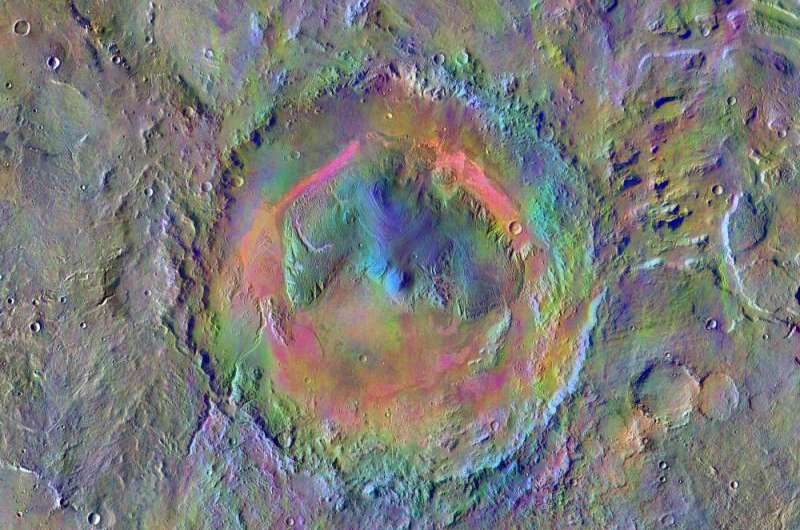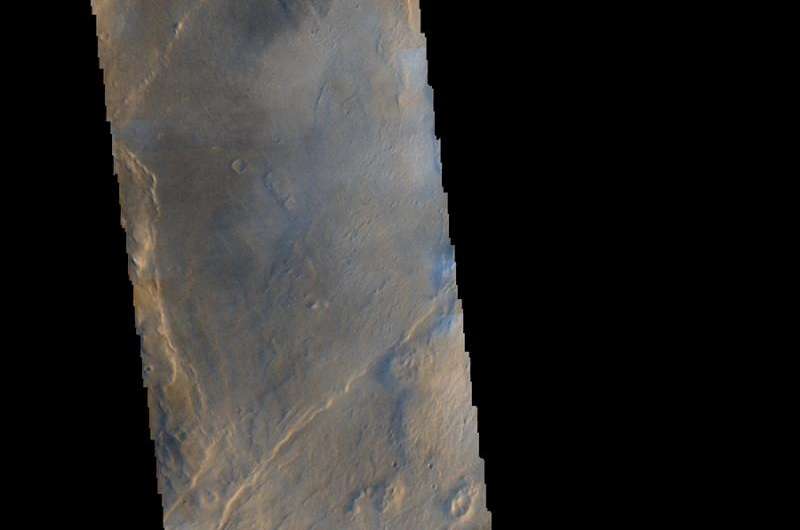Mars camera makes 60,000 orbits of Red Planet

Next week, a visual and infrared camera designed at Arizona State University will pass 60,000 orbits of the Red Planet.
It is carried on NASA's Mars Odyssey orbiter, the longest-operating spacecraft from any nation at Mars. The long run has allowed the camera to take nearly 400,000 images, enabling scientists to map much of the planet's surface.
The camera – the Thermal Emission Imaging System (THEMIS), which operates in five visual and nine infrared (heat-sensitive) "colors" – was designed by ASU professor Philip Christensen, the instrument's principal investigator.
"Mars Odyssey's enduring success has let THEMIS achieve a longer run of observations than any previous instrument at Mars," said Christensen, Regents Professor of Geological Sciences and the Ed and Helen Korrick Professor in the School of Earth and Space Exploration at ASU.
"THEMIS has thus provided the context for most recent Mars scientific research. We're very grateful to the scientists, engineers and technicians who have kept the spacecraft in good health."
He added, "THEMIS also continues a tradition of ASU instruments working at Mars. This began almost 20 years ago, with our Thermal Emission Spectrometer (TES), which flew on NASA's Mars Global Surveyor, operating from 1996 to 2006."
Even today, Christensen said, he uses THEMIS in his class for first-year undergraduate students. He challenges the class to think of a geology problem, and the students then target THEMIS to take images to resolve the question.

"THEMIS brings Mars exploration directly into their studies," he said.
As of this week, THEMIS has produced 208,240 images in visible-light wavelengths and 188,760 in thermal-infrared wavelengths. THEMIS images are the basis for detailed global maps and for identification of some surface materials, such as chloride salt deposits and silica-rich terrain. Its infrared imaging also indicates how quickly different parts of the surface cool off at night or warm up in sunlight, which provides information about how dusty or rocky the ground is.
These observations have allowed scientists to map the properties of the surface materials over nearly all of Mars. A particular area of interest is 96-mile-wide Gale Crater, currently the exploration site of the Mars Science Laboratory rover, Curiosity.
Mars Odyssey began orbiting the Red Planet on Oct. 23, 2001. It will complete orbit 60,000 on June 23, 2015.
"The spacecraft is in good health, with all subsystems functional and with enough propellant for about 10 more years," said Mars Odyssey project manager David Lehman of NASA's Jet Propulsion Laboratory.
Besides conducting observations, Odyssey also serves as a crucial communications relay to Earth for the two active rovers, Curiosity and Opportunity, operating on the Martian surface.
Dawn patrol
In 2014, Odyssey began a gradual drift in its orbit designed to begin passing over terrain lit by early morning sunlight rather than afternoon light. In its orbit, the spacecraft always flies near each pole. Its current orbit flies along the "terminator" line between night and day both on the northbound and southbound halves of each circuit. The drift will be halted later this year with a maneuver to lock in the Martian time of day that Odyssey crosses the equator.
The goal of the orbit change is to let THEMIS systematically observe the Martian atmosphere and surface shortly after local sunrise. This is to detect transient atmospheric features such as frosts, fogs, hazes and clouds that burn off or vanish as the Martian day goes on.
Already, an example of this are the clouds that gather around the upper slopes and in the vast summit pit (caldera) of Pavonis Mons. This is one of the giant volcanoes in the Tharsis area, with a summit that reaches about nine miles above the average radius of Mars, a datum that serves as "sea level."
Christensen says, "Pursuing a 'dawn patrol' with THEMIS gives us hope we can catch in the act and study daily effects, seasonal ones, and even those which we think change from year-to-Martian-year."





















